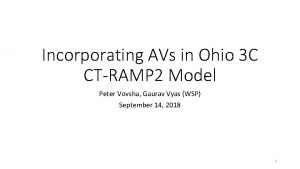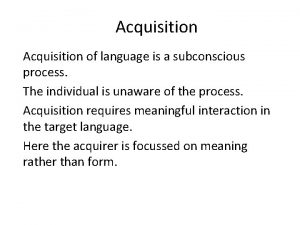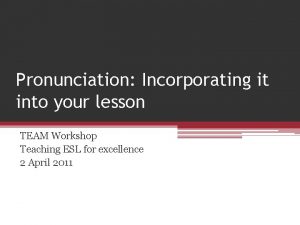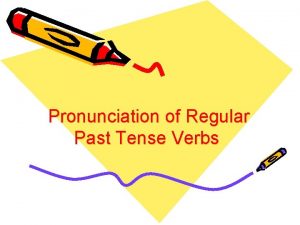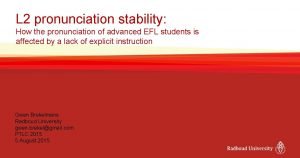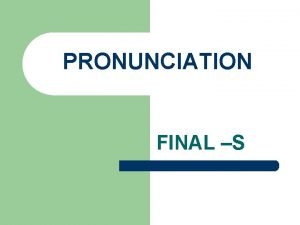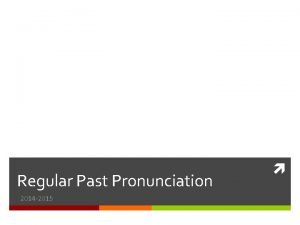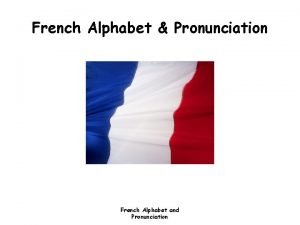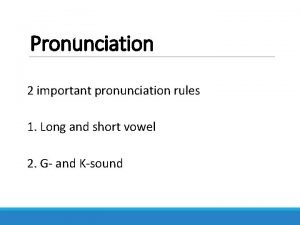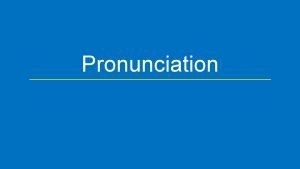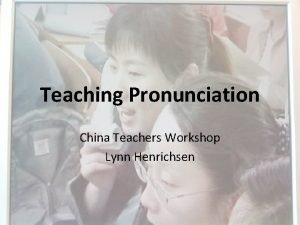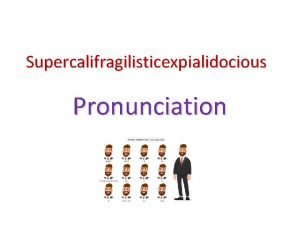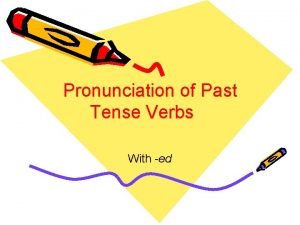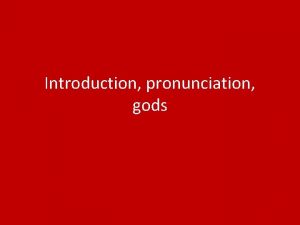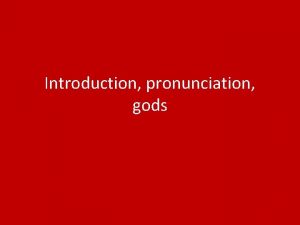Pronunciation Incorporating It Into The Language Learning Process


















- Slides: 18

Pronunciation: Incorporating It Into The Language Learning Process From Day One Diane Boardman, M. A. , CCC-SLP dbspeech@earthlink. net

WHY THIS TOPIC?

Background Concepts and Information How is Speech Produced?

Background Concepts and Information What is a Speech Sound?

Background Concepts and Information Letters vs. Speech Sounds g Phonetic transcription to denote speech sounds as opposed to letters. Y Some letters pronounced > 1 way: Ex. : “c” in “cat” pronounced as /k/; and “face” pronounced as /s/ Y Some sounds are assigned > 1 letter: Ex. : Sound / s / uses letters “c“ and “s” as in “cease” Y Vowel letters > 1 pronunciation: Ex. : Letter “a” pronounced as /ae/ “cat”, /a/ “father”, or /ei/ “late”

Background Concepts and Information V Three parameters for distinguishing one speech sound from another: T Mechanical placement of oral structures T Airflow T Voicing

Subjects to be covered T Intonation: T Questions T 2 -Syllable Nouns and Verbs, including Heteronyms T Can vs. Can’t T “th” and use of this in the most frequently used words

Intonation YWhat is this? Rhythmic quality of the language. UEnglish: Is a stress-timed language. USyllables may last different amounts of time. UEx: “about” - The stressed syllable is “bout”. UCompared to “a”, it takes longer to say and the pitch rises UFrench: Is a syllable-timed language. USyllables all take approximately the same amount of time.

Intonation Y�Also includes pitch changes, what words to stress in a sentence, and types of links or liaisons in connecting sounds within and between words. YBoth English and French use linking (yay!!). IT’S THE MELODY OF THE LANGUAGE

Intonation in Use � YQuestions YRule: Pitch drops at the end of a question sentence. Ex: Would you like coffee or tea? YExceptions: WYes/no questions: Ex: Would you like some coffee? UHighly emotional questions: Ex: Why don‘t you pay attention to me?

Intonation in Use Y 2 - Syllable Nouns and Verbs U For 2 - Syllable Nouns in general, stress is on the first syllable: U Ex: baby, finger, journey, soldier, dinner, bottle, paper, sorrow, elbow, shadow U For 2 -Syllable Verbs in general, stress is on the second (last syllable): U Ex: repair, attack, approach, invite, rely, annoy, forget

Intonation in Use Y 2 - Syllable Nouns and Verbs (cont. ) T Heteronyms T When a 2 -syllable word can be used either as a noun or verb, the same rules apply. Examples: T contract T “I signed a contract. ” OR T “I will contract that disease if I’m not careful. ” T permit T “I need a permit to set up a march. ” OR T “Permit me to pay for this meal. ” T Other examples: content, record, subject, present, convict, object, contrast, project, defect.

Intonation in Use TCan vs. Can’t T 1 a. Can When “can” is used with another verb, we do not stress it. We stress the verb that follows. Our pronunciation becomes “cn” (/kn/), as if the vowel didn’t exist. Examples: I can (/kn/) do it. Can(/kn/) you lend me $5. 00? I can (/kn/) go later. Those Can-Can girls can (/kn/) sure dance. T 1 b. Can However, when “can” finishes a sentence, there is heightened emotion, or you are contradicting someone, it is said completely (full vowel). Examples: I can! Speaker#1: You can’t swim. Speaker #2: I can swim. I do it every day

Intonation in Use TCan vs. Can’t (cont. ) T 2. Can’t : TWe stress this word: The vowel is said fully, the pitch rises and it takes longer to say. Examples: You can’t do it. You can’t go to the movies. If I can’t go, you can go. (Compare with: If I can go, you can go. ) Examples of Both Can and Can’t: Can he come if you can’t? I can see that he can’t handle the job.

“TH” /θ/ /ð/ THow produced: TOral structures: Tongue touches the back of the upper teeth. TAir Flow: Fricative. Air is pushed through a narrow passage and sounds like a hiss. TVoicing: Can be either voiced or voiceless. Examples: Voiceless: think, theater Voiced: brother, that

“TH”/θ/ /ð/ TThe, this, that, these, those, there, with “the”: “that”: “with”: “this”: “there”: Most used word in English language Number 7 Number 17 Number 23 Number 35 TEmphasize the difference between “this and “these”. TWhy? - Difficulty with which is singular/which plural. - Difficulty with pronouncing them differently even when they know the differences in the meanings: - Native English speaker will think they don’t know their grammar: “This are mine. ”

“TH”/θ/ /ð/ TPronouncing “this” vs. “these”: TSimilarity: TBoth begin with voiced “th” TDifferences: TVowel: / I / in “this” and /i/ in “these” TFinal Sound: Voiceless /s/ in “this” Voiced /z/ in “these” (they need to feel the “buzz” in their necks)

Pronunciation: Incorporating it Into the Language Learning Process from Day One FINAL QUESTIONS? Diane Boardman, M. A. , CCC-SLP dbspeech@earthlink. net
 Incorporating pronunciation
Incorporating pronunciation Incorporating the change
Incorporating the change Nn
Nn Incorporating quotes
Incorporating quotes Incorporating in ohio
Incorporating in ohio Unconventional cash flow
Unconventional cash flow Cuadro comparativo entre e-learning b-learning y m-learning
Cuadro comparativo entre e-learning b-learning y m-learning Language acquisition is a subconscious process
Language acquisition is a subconscious process Comprehensible input
Comprehensible input Scienze della formazione
Scienze della formazione Hát kết hợp bộ gõ cơ thể
Hát kết hợp bộ gõ cơ thể Slidetodoc
Slidetodoc Bổ thể
Bổ thể Tỉ lệ cơ thể trẻ em
Tỉ lệ cơ thể trẻ em Chó sói
Chó sói Chụp phim tư thế worms-breton
Chụp phim tư thế worms-breton Alleluia hat len nguoi oi
Alleluia hat len nguoi oi Các môn thể thao bắt đầu bằng tiếng bóng
Các môn thể thao bắt đầu bằng tiếng bóng Thế nào là hệ số cao nhất
Thế nào là hệ số cao nhất




